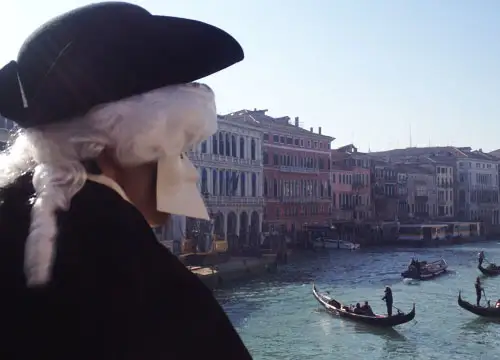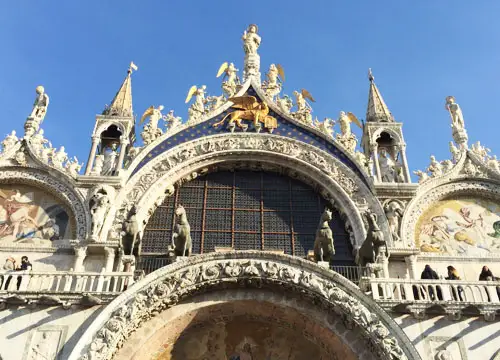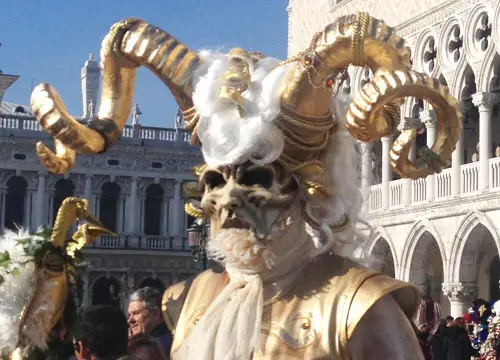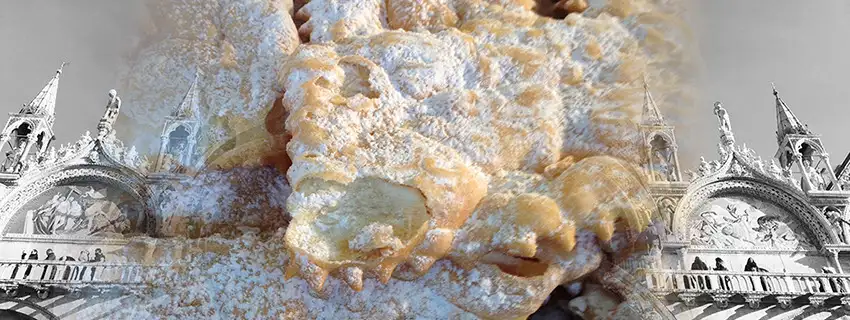Published:
Author: Antonio Maria Guerra
Venetian Frittelle
THE COMPLETE GUIDE TO THE CARNIVAL SPECIALTY

Among the many ‘attractions’ that make a visit to Italy during Carnival an absolute must, there is the Venetian frittelle (fritters), one of the most typical expressions of the lagoon’s pastry tradition and a real must for any gourmet. In this guide we will discover what they are, how they are prepared, the many variations, combinations, calories and much more. With the invaluable help of Venice’s oldest pastry shop, we are going to embark on a delicious journey to discover one of Veneto’s most popular specialities. Enjoy reading!

What is Venetian frittelle?
Venetian frittelle, or frìtole, is one of the most typical desserts of the lagoon city, a real concentration of flavor and tradition. The specialty consists of soft balls of leavened dough, expertly fried and sprinkled with icing sugar. Although the most classic recipe calls for sultanas and pine nuts to be added to the dough, over time, many variations have been invented, such as those enriched with custard or zabaglione cream. These delicacies have accompanied the Carnival in the lagoon since the days when the so-called fritoleri prepared them along the festive calli, enriching the joyful atmosphere with an irresistible aroma.
The origins of the Venetian frittelle.
It’s not an easy task to establish with certainty the date of birth of a specialty such as Venetian frittelle. According to some scholars, as it’s often the case with many Italian dishes, its origins may date back to ancient Rome, when something not very different was eaten during the Saturnalia celebrations: the so-called ‘globulos’, made with durum wheat semolina and cheese, cooked in fat and seasoned with honey and poppy seeds. It should be added that there is evidence of similar preparations in other historical periods, from the 14th century to the Renaissance and beyond.(more information)


Venetian frittelle: ingredients.
Although there is no official specification indicating the exact ingredients of the most classic Venetian Frittelle, it’s easy to identify those generally used for the preparation of the exquisite specialty.
- Flour 00;
- Milk;
- Eggs;
- Water;
- Yeast;
- Raisin;
- Pine nuts;
- Grappa;
- Grated lemon peel;
- Granulated sugar;
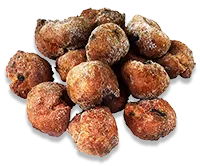

Pasticceria Rizzardini and the tradition of frittelle.
This article has been realized in collaboration with the Pasticceria Fratelli Rizzardini, which, besides being the oldest in Venice, is also the ‘keeper of the tradition’ of the Venetian frittelle. Founded in 1742, for almost three centuries this enchanting pastry shop has been delighting the people of the Serenissima and many tourists with the most typical lagoon sweets.
(more information)

Venetian Frittelle: recipe (hints).
As explained in another section of this article, the ingredients needed to make the most classic Venetian frittelle are eggs, flour, caster sugar, milk, brewer’s yeast, sultanas, grated lemon rind, vanilla and pine nuts. To prepare the dough, beat the eggs with the sugar, then add the flour and, if necessary, a little milk. Then add the sultanas, soaked in lukewarm water to soften them, the grated lemon zest, vanilla, pine nuts, and a little white grappa. Finally, add the brewer’s yeast dissolved in lukewarm water. Leave the dough to rise in a warm place, away from draughts, for about 4-5 hours. When the dough has risen, place small portions (spherical or even pancake-shaped) in hot oil using an ice cream scoop or a simple spoon. The delicacy is ready, all you have to do is dip them in icing sugar.
Frittelle in video.
In this very funny video, made by an equally funny cook in pure Venetian dialect, the preparation of Venetian frittelle is shown. Many thanks to StefanoSoffiato the YouTube channel owner of the footage, and its author.

Venetian frittelle: the variants.
It’s fascinating to think that a dessert such as the Venetian frittelle has managed to survive over the centuries and maintain a large number of admirers. It’s worth noting that this specialty has evolved over time, giving rise to numerous variants that, today, further enrich the offer of Venetian pastry shops during Carnival. In addition to the most traditional version, the one with sultanas and pine nuts, we can also find the one filled with custard, which has also become a classic, the one with zabaglione or pistachio cream, the one filled with ricotta cheese, or the one with chocolate. We have just mentioned the most famous and widespread delicacies, but it must be said that, almost every year, new and daring are born, demonstrating the ability of some delicacies to reinvent themselves.
Galani, also known as crostoli, are, along with the famous frittelle, one of the most typical Carnival sweets in Venice. They are thin sheets of sweet pastry, fried and sprinkled with icing sugar. Their texture is crisp and crumbly, thanks to a special treatment of the dough that gives them the appearance of a wavy ribbon.
Read more about this specialty in the article we have dedicated to it.

Venetian Frittelle ... with the hole.
It’s interesting to find out that frittelle were once cooked in the streets of Venice with a spit, that often consisted of a thin bamboo cane. This tool was useful both to cook the inner part of the speciality and to avoid burning oneself or, more simply, getting greasy hands. Nowadays, this particular method of preparation is only used by a few pastry shops of the Serenissima.
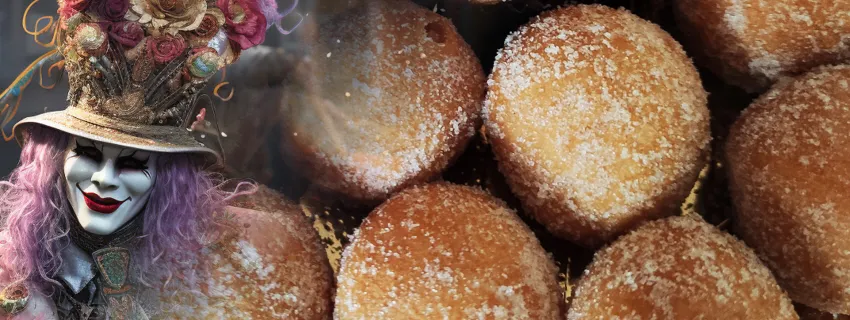
The ‘castagnole’.
Speaking of Venetian Carnival sweets, it’s important to mention the ‘castagnole’ (*1), which can be considered the ‘little sisters’ of the frittelle. This is because, although they have a greater consistency, they are generally smaller in size. They are made from a mixture of flour, eggs, butter and sugar (*2), which is used to make balls that are fried in oil (*3) and sprinkled with sugar.
Notes:
*1: Castagnole are also prepared in other parts of Italy, where they are known as ‘fave’ or ‘favette’.
*2: There is usually no filling.
*3: There is a variant, more dietetic but obviously less tasty, baked in the oven.

Venetian frittelle: calories and nutritional values.
The most classic Venetian frittella, i.e. the one enriched with sultanas and pine nuts, contains an average of between 200 and 250 calories per portion: a value that, of course, can vary according to the size of the portion and the amount of ingredients used. In terms of nutritional value, this specialty contains mainly carbohydrates (from the flour and sugar) …
Read more
… a small amount of fat (from the frying oil), and protein (from the egg). Sultanas contribute with a small amount of fibre and minerals, while pine nuts provide fatty acids and vegetable protein.

Pairings: ‘Malvasia’ wine for Venetian frittelle.
In the city of Venice, as in the rest of Europe, since the Middle Ages and for many centuries to come, ‘Malvasia’, or rather ‘Malvasias’, have been considered the most precious wines (*1). The plural has a specific reason: it was in fact used to refer to the fruit of not one, but several varieties of vine, united by the fact that they came from the countries bordering the eastern Mediterranean (*2). Quite soon the name became synonymous with sweet, aromatic wines (*3). With their good acidity, these wines were, and still are, the perfect accompaniment to specialties such as frittelle and galani.
Notes:
*1: Venetian aristocrats used to taste these wines in shops that, not surprisingly, were also called ‘malvasie’: true ancestors of today’s wine shops.
*2: Most probably the name ‘Malvasia’ derives from that of Monemvasia, a Greek city in the Peloponnese, located on an island that was for a long time a stronghold of the Serenissima.
*3: Not all types of Malvasia were sweet: there was in fact at least one dry type, known at the time as ‘garba’.
Copyright information.
The images displayed in this page belong to WebFoodCulture, with the exception of:
Public Domain images
- ‘Opera di Bartolomeo Scappi …’, B.Scappi, XVII sec. (Wikipedia Link) {PD-Art} {PD-US}
- ‘Venditrice di frittelle’, Pietro Longhi, 1757 (Wikipedia Link) {PD-Art} {PD-US}
- Sugar mill, XVIII sec. (Wikipedia Link) {PD-Art} {PD-US}
- ‘Santi Giovanni e Paolo e la Scuola di S.Marco’, Canaletto, 1726 (Wikipedia Link) {PD-Art} {PD-US}
- ‘S. Geremia e l’ingresso di Cannaregio’, Canaletto, 1727 (Wikipedia Link) {PD-Art} {PD-US}
- ‘Piazza San Marco’, Canaletto, 1730/34 (Wikipedia Link) {PD-Art} {PD-US}
- ‘Il Bucintoro attraccato nel giorno dell’Ascensione’, Canaletto, 1740 (Wikipedia Link) {PD-Art} {PD-US}

